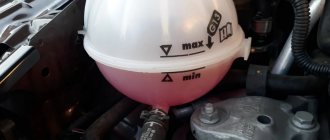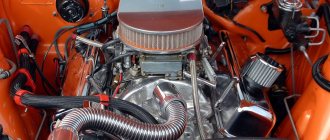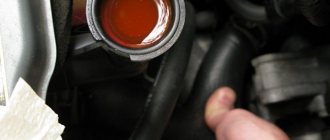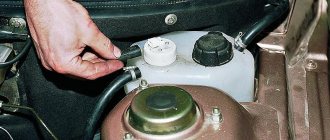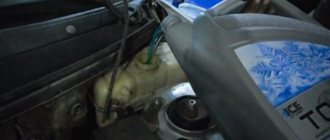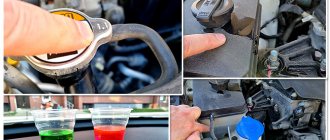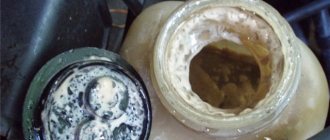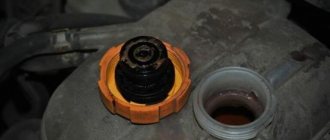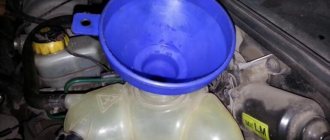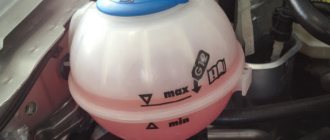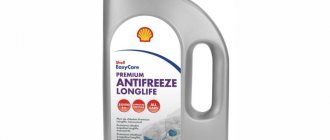The appearance of an antifreeze leak in the cooling system of a VAZ 2107 is a serious enough problem to pay attention to it and immediately begin to fix it. Leaking coolant can cause overheating and even engine failure.
The VAZ 2107 has many places susceptible to antifreeze leaks:
- Cooling radiator;
- Pipes and their connections;
- Water pump or water pump;
- Heater tap;
- Heater;
- Cylinder head gasket.
For each of the above places there are different ways to fix the problem. Naturally, the simplest method is to replace the damaged element. This applies to all possible problems, unless antifreeze is leaking at the connection points of the pipes. In this case, replacement will most likely not be required; just tighten the clamp.
Clear downgrade problems
This is not entirely relevant to our question, but it’s worth mentioning. This needs to be checked first, and if you have not identified the reasons, then we will dig deeper. So, antifreeze may leak due to a leak in the system, let’s look at it point by point:
- Engine radiator leaked . Of course, this can be determined very quickly, just look at it and also look at the stains under the car; if it is leaky, there will be red, green or blue drops. Of course, you can try to solder or clamp the radiator tubes, but often the plastic component (sidewalls) is damaged, there is nothing you can do about it, you need to replace it.
- Heater radiator . Almost the same picture, only the interior heater is leaking, it is more difficult to diagnose, because the coolant will drip onto the seal (carpet) in the cabin. But the reasons for the determination are simple: if there is a smell of antifreeze in the cabin (sweet smell), but not outside. If the glass sweats even in dry weather, and there is an oily coating on the glass. Liquid leaving the tank means your heater radiator is covered, of course, if you remove the plastic (decorative) protection of the instrument panel, you will see that it is dripping somewhere. We do the same, either restore it, or if this is impossible, change it.
- Hoses . They wear out over time, because they expand each time (when the engine heats up) and contract (when it cools down), such work will sooner or later damage them, they will not be able to hold pressure and will rupture. Of course, there may be minimal damage, but it will leak constantly. It is useless to make hoses; it is better to replace them.
- Tubes _ The situation is the same as with hoses, they are metal and usually last a long time. But there are situations when they also occur.
- Thermostat and pump . These are two mechanisms that are designed to pump and regulate the flow of coolant; the housings are made of metal or plastic and they often leak, this happens from time to time. For replacement, they are practically not repaired.
- The cap of the expansion tank and the tank itself. The cap is a valve , after a certain mileage it also fails, if it does not hold pressure, then antifreeze from the expansion tank can splash out when warming up. The tank itself may also burst, because it is made of plastic; if the lid is faulty, it may rupture. For replacement.
These are obvious reasons, they are worth checking first - ALWAYS! It often happens that the driver searches and cannot find it, but antifreeze (antifreeze) goes into, say, the stove and then into the passenger compartment, which is quite difficult to immediately determine. Park the car in a dry area or in a garage, if possible, and observe, if there are stains the color of your coolant, then this is definitely a leak, look for it!
Antifreeze leak: what are the main causes and how to diagnose the problem
The leak itself is only a symptom of some kind of malfunction. We have already figured out what to do when a leak is detected. Now let's figure out how to understand what exactly the problem is.
Find out the main possible signs and causes of an antifreeze leak.
A seemingly simple cooling system is insidious in that it directly cools the engine, and therefore antifreeze can leak not only outside, but also inside – into the engine. So, we list the main signs that there are problems in the cooling system:
- puddles and wet spots under the car;
- wet floor in the cabin (and the liquid feels oily to the touch and does not resemble water);
- drop in coolant level in the expansion tank;
- poor performance of the interior heater (cold air from the “stove”);
- frequent engine overheating, steam from under the expansion tank cap;
- the smell of antifreeze in the cabin;
- foam in the expansion tank;
- white smoke from the exhaust pipe.
Of course, there can be several reasons for the leak. Let's go in order, from the more obvious to the more complex.
If the car does not boil or overheat, the interior floor is dry, and the antifreeze level is constantly falling, then most likely the cause is a banal leak. The main potential leak points to check are:
- expansion tank;
- radiator;
- connecting hoses and their immediate attachment points;
- water pump gasket;
- thermostat seal.
You will notice that the list includes almost all the engine compartment elements of the cooling system, and this makes the check somewhat labor-intensive
The main attention should be paid to the little things: for example, cracks in the expansion tank are very difficult to notice - they are very thin and expand only at high temperature and pressure in the cooling system. The situation is similar with hoses.
A defective radiator is a very common cause of loss of coolant: its thin channels can easily be damaged by a stone or other hard object caught in it while driving. Thermostat and pump gasket leaks are usually more obvious due to wet spots in the area. Well, in addition, the pump may collapse due to age and wear, but in this case the fluid flow will be such that it will be difficult not to notice.
This is a fairly easy problem to diagnose. If the level of antifreeze drops, and there is a puddle of oily liquid under the feet of the passenger or driver, then this is most likely the same antifreeze that is missing in the tank.
To verify the problem inside the cabin, you can disconnect the heater inlet and outlet pipes under the hood and “loop” them together. If the antifreeze level stops falling, the problem is definitely inside: it’s either the radiator, or the pipe, or the tap.
This is the most serious, costly and difficult problem to resolve. If the car overheats, foam appears in the expansion tank, there are problems with the heater, and white smoke comes out of the exhaust pipe - this is most likely a leak of antifreeze into the cylinders. Moreover, in practice, not all of the above symptoms may be present. Two more signs of antifreeze leaking into the engine are a white coating on the spark plugs and a whitish emulsion on the engine oil dipstick. Among the causes of the problem are a breakdown of the cylinder head gasket, warping of the cylinder head itself, a crack in it, or its severe corrosion.
To eliminate such a leak, you will need to remove the cylinder head and carry out a thorough inspection, as well as checking and, if necessary, grinding on a special stand. The cylinder head gasket is replaced with a new one. The most unpleasant possible defect is a crack in the cylinder head: in this case, it will most likely need to be replaced.
It is worth noting: sometimes the cause of a car “boiling” is a problem with the expansion tank cap. It has a special valve designed to compensate for pressure fluctuations in the system - and if it is faulty, the operation of the cooling system is disrupted. Therefore, if the car is boiling, you should start solving the problem by checking and replacing the expansion tank cap.
Another potential cause of overheating is a failed thermostat. If its valve “sticks” in the closed position, then the liquid does not circulate through the radiator and is not cooled. Therefore, if the cooling temperature has risen to critical, feel the radiator inlet and outlet pipes - if they are cold, the problem is in the thermostat.
Source
Hidden problems
You have looked at everything and everyone, there are no leaks anywhere, all the hoses and clamps are in order, but the antifreeze or antifreeze goes away, “even if you crack”! The fact is that there are not only open leaks, but also so-called hidden ones, and they are much more dangerous.
A car engine is not a cast structure - there is a separate engine block and cylinder head. There is a gasket between these two parts, this is mandatory, it is high-temperature (can maintain high positive values), and it is also a sealing link. In the engine block, as well as in the cylinder head, there are channels through which antifreeze (antifreeze) passes, cooling the metal, thus the “entire engine” is at an operating temperature that does not exceed 90 - 100 degrees Celsius, without this fluid the engine would very quickly warmed up and it simply jammed.
So, the coolant also passes through the gasket, since it is an intermediate link (by the way, it has special channels). If the gasket is defective or poorly tightened, the tightness of the channels is broken and coolant can pass into the engine cylinders. That is, it will enter the combustion chamber, then through this chamber it will exit into the exhaust pipe, while the level of antifreeze (antifreeze) will decrease in the expansion tank.
What are the signs of such a breakdown?
- This is white and thick smoke from the exhaust pipe, it will really be like fog - we read about it here .
- The engine oil level will rise.
- The oil will be interspersed with antifreeze or antifreeze, that is, with bubbles.
- Coolant will leak out of the reservoir, and constantly.
In this case, it is 100% a gasket; we must change it. After all, sometimes antifreeze or antifreeze can get into the engine oil, and this is serious! Here the capital is just a stone's throw away.
- The oil mixes with the liquid and forms an incomprehensible “slurry”; it will begin to coagulate, which will clog all the channels - overheating of the engine is guaranteed.
- It will not be able to properly lubricate the engine cylinders, this will lead to wear of the piston rings.
- Also, this substance will clog all the channels on the crankshaft, which will also increase its wear; the liners in which it rotates can simply turn.
Bottom line - if antifreeze or antifreeze goes into the engine, driving is prohibited!
This is reason number “1”, however, antifreeze can also flow through various channels of the cooling system. They also have gaskets adjacent to the engine block and when they wear out they leak.
Assembly and installation of the stove
- You will first have to attach the pipe and tap to the new radiator. Rubber gaskets must be replaced. You must first coat them with silicone sealant. The nuts should be tightened without fanaticism, so as not to squeeze out the rubber gaskets.
- After installing the radiator in the casing, it is necessary to treat the outer surface of the metal pipes with sealant. After this, clean hoses are put on them in the engine compartment and the clamps are clamped.
- Now it is necessary to add coolant and check the tightness of the connections.
- You can start the car without forgetting to monitor the connections for dryness.
Additional adjustment of the spark plug gap guarantees faster engine starting. How to choose the optimal spark plug gap gauge and how to properly adjust the spark plug gap?
Types of fuel filters for the VAZ-2110 and the need to replace them. A detailed description of the process of replacing the fuel filter. Rules for observing safety precautions during repair work.
Features of the design of the front suspension of the BAZ-2110 and a description of its possible malfunctions. How to check the technical conditions of the front suspension. List of indications for replacement/repair of various elements of the front suspension.
The other day I noticed a couple of drops of antifreeze in the cabin, next to the gas pedal, that is, on the right side of the stove. Well, I think the heater radiator is leaking and needs to be replaced. I went to the store, I said the heater radiator for a VAZ 2104. The seller told me there is a wide one and a narrow one, he showed me, one radiator is normal, the other is a little wider. I took the usual one, as it was on my other fours, although the box said 2101-06, the seller said that they mixed it up again when they signed it. I also took 3 silicone gaskets. They wanted to give us the usual black ones, but I noticed these pink ones on the counter and asked for them) Tuning spare parts won’t hurt
